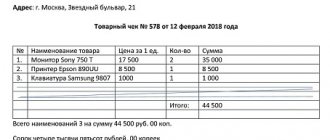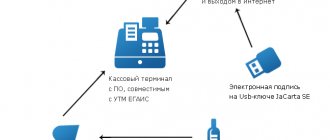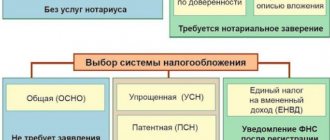What is a trademark and why is it needed?
A trademark (TM) is a distinctive designation of a product.
It allows the manufacturer to stand out in the market, and customers not to confuse the brand with others. Art. 1477 Civil Code of the Russian Federation
For example, there are two packages of cereal, each with the manufacturer's trademark printed on it. The buyer will remember which brand of cereal tastes better, and next time he will be able to find it in the supermarket.
The exclusive right to a trademark is valid for 10 years. It can be “renewed” an unlimited number of times, but only by re-registering.
You need to register a trademark in each country where you plan to operate, and use it constantly. The rights to it are canceled ahead of schedule if the technical specification is not applied continuously for 3 years.
Art. 1478 Civil Code of the Russian Federation Art. 1479 Civil Code of the Russian Federation P. 1 Art. 1486 Civil Code of the Russian Federation
Certificate form
Now a certificate of registration of a trademark is issued in a form approved by Order of the Ministry of Economic Development of July 20, 2020 No. 483. The form depicts the coat of arms of the Russian Federation and indicates the following data:
- the state registration number of the trademark, which is also the number of the certificate itself;
- TK image;
- data of the copyright holder: full name of the individual entrepreneur or full name of the organization, as well as the code of the country of location or residence;
- registration application number;
- date of registration in the State Register of Trademarks and Service Marks of the Russian Federation;
- the priority date of the trademark and the expiration of the exclusive right to it.
An insert is issued with the certificate, on which, in addition to the information listed, the following is indicated:
- classes of the International Classification of Goods and Services in respect of which the trademark is registered;
- characteristics of the mark, including indication of color, if any;
- presence of unprotected elements of the sign;
- numbers and dates of other legally related applications and trademarks, if any.
On January 17, 2021, Law No. 217-FZ dated July 20, 2020 comes into force, according to which trademark certificates will begin to be issued electronically. It will be possible to receive a document in paper form only at the request of the copyright holder.
What can a trademark be?
Verbal - just a name. For example, Coca-Cola, Facebook or Panasonic.
Fine - Adidas, Chanel and Apple logos.
Volumetric - original packaging, shape of the product. For example, a traditional Hennessy bottle.
Combined - for example, a word and an image, a logo and the shape of the container, etc. These include the Wella hair cosmetics trademark, which consists of a schematic drawing of a woman and the brand name. This is the most reliable type of trademark.
Sound - like the musical screensaver of radio “Mayak” (intro of the song “Moscow Nights”).
Olfactory - the rarest category.
For example, in Australia, a spa salon registered the scent of lemongrass as a trademark.
Types of trademarks: verbal, visual, sound, light, olfactory, combined
Most people are accustomed to seeing trademarks of well-known companies in the form of inscriptions or images (logos).
However, an interesting fact is that a trademark can also be a piece of music (a catchy melody), the shape of the product itself or its element.
Thus, it is possible to register a light, sound or olfactory trademark. They are registered infrequently and can be done if desired.
An advertisement that blinks in a certain way or a special smell emanating from a product can also be an object of intellectual property.
For example, the shape of a Coca-Cola bottle with characteristic grooved stripes on the glass also acts as a trademark along with its logo, and if you start producing drinks in exactly the same bottle shape, you will be violating the company’s rights to a special branded bottle, and then Coca -Kola has the right to hold you accountable.
The Coca-Cola bottle design is a registered trademark in most countries
A wordmark consists of just a word or phrase, sometimes written in a regular font like Times New Roman, sometimes in a branded font like Coca-Cola.
Combined trademarks consist primarily of a graphic image and an inscription.
Often, from a design point of view, a logo and a word (phrase) complement each other in meaning, but not always.
In the picture below, I gave an example of the SONY and KFC trademarks to clearly show examples of different types of technical specifications: verbal (word only) and combined (word plus image).
A verbal trademark using the example of “SONY” and a combined trademark using the example of “KFC”
The logical question is which trademark to register: verbal, figurative or combined?
It is impossible to give unambiguous advice here; in my subjective opinion, it is better to use a combined trademark, since it is more universal. Although in the world of brands we see verbal, visual, and other technical specifications.
What cannot be a trademark:
- state symbols and signs (country flags, etc.);
- names of international and intergovernmental organizations, their symbols and signs (United Nations);
- generally accepted symbols and designations (for example, a red cross);
- elements of product designation that have come into general use (Orenburg downy scarf);
- information that misleads the consumer (for example, it is impossible to register the mark “Russian Real Estate Agency”, because potential clients may perceive this organization as a state-owned one);
- designations similar to already registered trademarks (the brand cannot be called “Alenka”, since “Alenka” already exists).
Designation requirements
The legislation allows the use of the following types of signs:
- verbal – names and slogans;
- figurative - in the form of a picture or symbol;
- combined - a striking example is the MasterCard logo (the name against the background of red and yellow circles).
Registration of the following marks is not permitted:
- generally accepted symbols and names;
- designations used for a certain group of goods;
- characterizing the product, place and method of its manufacture;
- contrary to moral standards;
- capable of misleading the consumer;
- previously registered by other persons;
- used in science and literature without the consent of the author or copyright holder;
- designations using famous Russian figures without their permission or the permission of their heirs.
The trademark name undergoes a thorough check before registration. Before contacting a government agency to register a designation, it must be checked for legality and for the absence of such a name among other registered brands. To do this, it is advisable to contact the patent office - a company that provides services for checking names in the Register of Trademarks, as well as designations that are under consideration.
Plagiarism check
To ensure registration is not denied, check the trademark for confusing similarity to other trademarks. This can be done using the paid database of the Federal Institute of Industrial Property or other services that have access to FIPS data. For example, Online Patent.
Signs are checked for three types of similarities:
- graphic (similar to another visually);
- phonetic (by ear);
- semantic (in meaning, idea).
Registration of a trademark for an individual entrepreneur: pros and cons
Positive aspects of acquiring your own name:
- recognition in the market;
- the possibility of protection in court due to violation of rights by competitors;
- a trademark for an individual entrepreneur becomes an integral valuable asset that can be sold;
- the ability to transfer the rights to the designation to third parties under concession agreements, leasing agreements or through a franchise;
- a registered mark can be encumbered in the form of a pledge;
- when changing the form of ownership, the designation is retained;
- if the entrepreneur does not use the designation, he may think about how to transfer the legal entity’s trademark to the individual entrepreneur (for a fee, free of charge, under a contract);
- a sign for which there is a certificate is inherited.
There are also negative aspects to registering a name. Such a procedure is expensive and time-consuming. The issuance of certificates, registration of applications and examination of the declared designation will cost at least 30,000 rubles. The processing time takes at least a year.
In addition, the registered mark must be used for its intended purpose, otherwise the certificate may be canceled after three years. That is, additional advertising costs should be taken into account.
On video: 5 reasons to register a trademark
What is needed to register a trademark
To register a trademark you will need the following documents:
- application for registration;
- designation of your trademark;
- description of the designation in free form;
- a list of goods and services for which you will use a trademark, compiled in accordance with the International Classification of Goods and Services for the registration of marks;
- confirmation of consent to the processing of personal data.
Documents must be submitted to Rospatent. You can do this in several ways:
- Personally to the head office of Rospatent, located at the address: Moscow, Berezhkovskaya embankment, 30, bldg. 1. Notification that a trademark has been registered will be sent by regular mail.
- In electronic form through the FIPS website or through Gosuslugi. The application must be certified with a qualified electronic signature. Read about how to get it here.
- By mail.
Difference between concepts: trademark, trademark, commercial designation, logo, brand
At first glance, all these concepts are similar in meaning, but if you look in more detail, the difference will be colossal.
- A trademark is a certain set of individual properties of a product or service image that distinguishes it from its analogues. In Russian legislation, the process of branding begins with a trademark - creating recognizable distinctive properties of a product or service. For simple understanding, a trademark is not a registered trademark. Yes, it is recognizable, but until it is officially registered with Rospatent it does not have legal protection, and then there is a danger that the trademark you created may already be someone else’s trademark, in which case you risk facing large fines for violating exclusive rights registered technical specification.
- A trademark is a distinctive feature of goods and services registered in accordance with the procedure established by law, which serves to individualize legal entities and individual entrepreneurs. The main distinguishing feature of TK from other above-mentioned concepts is its legal protection. And as a result, technical knowledge as a business asset can be turned into real money or other benefits can be obtained: rented out, concluding a license agreement, sold, donated.
- Commercial designation – used to individualize the company itself. For example, the design studio of Vasily Ivanov or the hairdressing salon “Romashka”.
- A logo is a graphic image aimed at creating a strong association in the consumer with the company, goods or services that it sells. A logo is a graphic (design) concept, and a trademark is a legal one.
- A brand is a stable psychological association in the minds of consumers regarding the quality of a company’s product or service. At its core, a brand may not be a registered trademark. The concept of brand is closely related to marketing.
On the contrary, registration of trademark does not mean that from that moment this image, word or combination thereof has become a brand.
Let us summarize the main differences between the 3 above concepts:
- A trademark is a legal category.
- Logo – graphic (pictorial).
- Brand – marketing (psychological).
Now you know exactly how these similar concepts differ.
How much does it cost to register a trademark?
The minimum registration costs will be 33 thousand rubles :
3,500 rubles - for registration of the application and formal examination (checking documents for compliance with the list);
11,500 rubles - for conducting a substantive examination (checking for uniqueness and compliance with legal norms);
16,000 rubles - for registering a trademark (if the decision of the patent office is positive);
2000 rubles - for issuing a certificate for a trademark.
How to register a trademark - step-by-step instructions
Here we will briefly consider the main stages of registration of technical specifications in order to have an overall picture of this process.
Step 1. Development of “creative” - how to come up with an idea and logo for the future technical specification
Whatever you call the boat, so it will float is a fair statement, especially if you do not yet have the very concept of the future “brand”.
What points need to be taken into account when developing a future technical specification: I call this stage “creating creativity.”
If you already have a logo, word or other elements of the future technical specification, then just skip this point and read on.
If you just have to come up with an idea and all the other points, then I believe that this stage is the most important of all those described here. Go!
Criteria for a good future TK:
- Individuality. If possible, your logo or word should be unique and not overlap with the names and images of other well-known companies, especially if you plan to operate in the same area as already well-known companies, for example, producing sportswear or shoes.
- Memorability. The future brand must be “embedded” in the consumer’s consciousness and form in him a positive, lasting image or association with benefits, quality, and high service.
- Simplicity. Both in pronunciation of a word (phrase) and in its writing (drawing) there should be no difficulties either for a child or for an 80-year-old grandmother.
- Harmony and aesthetics. When spoken or heard, the potential client should not have negative or vulgar associations with your “creative”.
- Unambiguity. If your company sells custom cakes and is called “Sea Breeze” and has a gun or a computer on its logo, it is unlikely to be successful among sweets and dessert lovers. At a minimum, then make the name and logo neutral, and ideally, if the company’s activity profile does not plan to change, reflect the essence of the goods produced.
For example: “Sweet woman” and a logo in the form of a cake, pastry, but with some twist that will set you apart from your competitors.
- Appropriate and small color palette. It is better to use from 1 to 3 colors, in rare cases up to 5, but no more. The colors themselves should at least indirectly correspond to the profile of the company or the product being sold. So, if you sell furniture, it is better to use brown, light or bed colors in your logo. Blue, yellow, and green are welcome in food products, especially if your company is positioned as a manufacturer of eco-products.
- Ease of application and scaling. When using a trademark, you will have to apply it to various surfaces of different sizes: from a pencil to a huge banner. Perhaps your logo will be embossed, for example, on a leather notepad, or burned into wood, as is the case with manufacturers of various drinks in bars. Imagine, or better yet, simulate applying the logo to large and small surfaces with different textures, and you will see whether it looks correct.
- Identical spelling in transliteration (in English letters) . This criterion is especially important for the future site name, which will be written in English. Compare the two names (hiterbober.ru) and “Painting sandblasting” (krasyashchijpeskostruj.ru). When you have to explain to customers how to type your website into the address bar, it is clear that it will be inconvenient, to put it mildly. You will encounter the same problem when writing a website address on company advertising materials: business cards, brochures, banners.
If you take into account all these criteria when creating the name and logo of your future trademark, believe me, you will most likely be successful. Tested by my own experience!
By carefully observing well-known brands, you will be convinced that all their trademarks meet the above criteria.
Dear reader, if you need to professionally develop the name and logo of your company (product or service), our website marketing specialists will help you. To do this, write to our support service with the subject “Brand creation services” and briefly describe the essence of the task.
Step 2. Determination of ICGS classes (types of goods and services)
ICGS is an international classifier of goods and services. Used to determine areas of activity when registering a trademark. Contains 45 classes - areas of activity that a company or individual entrepreneur can engage in under its own terms of reference.
From 1 to 34 classes in the ICTU there are goods, from 35 to 45 - services.
For example, if you are going to produce paints and varnishes, then you should choose class No. 2 “paints, dyes, corrosion protective agents”, and if you want to advise businessmen on promoting the same paints and varnishes and provide them with marketing and advertising services, you need choose class No. 35 “Advertising, business management.”
Each class of the ICGS contains dozens of types of highly specialized areas of activity. You can choose either hotel destinations or the entire class.
The more classes you register for your technical assignment, the more expensive the procedure itself will be, since you will need to pay extra for each class beyond one.
If you have been involved in business before, you are probably familiar with the concept of OKVED , in our case MKTU - an analogue of OKVED, only for registering a trademark.
Step 3. Submitting an application to Rospatent - document templates with explanations
Submission of an application is carried out using this form ()
The applicant’s data is filled in, and an image of the future technical specification is attached (if it is registered in pictorial form).
You can track the status of your application on the FIPS website (Federal Institute of Industrial Property of the Russian Federation).
Please note that to receive data you must enter your application number in this box:
On the FIPS website you can find out the status of the application for registration of technical specifications
It will be displayed indicating the current status in this form:
Appearance of the application on the website of the Federal Institute of Industrial Property
Step 4. Passing the “formal examination” stage
Formal examination is a check of documents for compliance with the requirements of registration and completeness of the information provided. Based on the results of this stage, the applicant is sent a decision either on a reasoned refusal to accept documents indicating the reason, or on successful registration of the application with the date of its submission.
If your application is accepted based on the results of the formal examination, then the fact that the registration authority’s response indicates the priority date of the application plays into your hands. This means that if, in the end, your trademark is nevertheless successfully registered, then even if someone else (possibly a competitor) submits an application a day later with exactly the same logo or name, your trademark will receive a pre-emptive right to register, and the “competitor’s” application will be declared invalid.
Formal examination period: 1 month from the date of application submission .
Step 5. Passing the stage “Examination of the declared designation”
More precisely, this stage is called “examination of the designation declared as a trademark.”
It involves analyzing the database of existing technical specifications for similarity with what is submitted in the application. The law has the following wording: “identical or confusingly similar.” This means that if the Rospatent database already contains exactly the same technical specification or one quite similar to it, then on the basis of this you will be refused registration.
However, if this happens, then there is no need to panic. You just need to refine your creative in such a way as to eliminate the similarities, and then registration will continue. Examination period for a designation declared as a trademark: several months from the date of successful completion of the formal examination.
Step 6. Trademark registration and obtaining a certificate from Rospatent
If all the previous stages were successful, then you will register a trademark and be issued a corresponding certificate. At this stage, you will also have to pay a state fee (the amount should be clarified at the date of completion of registration of the technical specification).
All! From this moment on, you (your company) are the legal owner of exclusive rights to your TK. You can begin to actively advertise it and thereby increase brand recognition and value.
Brand development
When developing a new trademark, you need to take into account that it must be different from previously registered designations. If complete or partial similarity is identified, Rospatent will reject the application. In addition, you can only obtain a certificate for designations expressed in the following forms:
- text objects transmitted using letters, numbers, words, abbreviations and other similar symbols;
- graphics, including logos, labels, etc.;
- combined forms (a combination of text and graphics in one designation);
- sound, volumetric and other designations.
In the application, the entrepreneur must describe the designation and reveal its essence. At the same time, it is necessary to indicate which classes of products will be subject to trademark protection. For this, the international classifier ICGS is used, and the size of the state duty depends on the number of classes.











